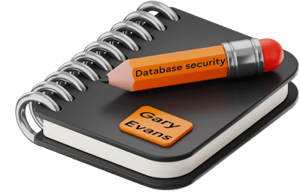Unlocking the secrets of encryption in database security (original) (raw)

In this article, I will decrypt the world of encryption in database security, and emphasize that encryption isn’t just about turning data into an indecipherable format – it’s a multifaceted shield safeguarding data at various levels, from resting quietly in your database to zipping through networks.

While encryption is powerful, it’s not without challenges. Performance overhead and the complexity of key management are common issues. However, the benefits far outweigh the challenges.
Understanding the different types of encryption, their usage, and the key management involved is crucial for any DBA looking to fortify their data fortress.
The goals of encryption in database security
Encryption’s primary goal is to protect the confidentiality and integrity of data. It ensures that even if data falls into the wrong hands, it remains useless without the proper keys. Here are the key areas where encryption plays a pivotal role in database security:
Encryption in transit
 Encryption in transit protects data as it travels across networks. Imagine your database data as a valuable package being sent through the mail. Encryption in transit is like a robust, tamper-proof packaging that ensures your package (data) reaches its destination (another system or user) without being intercepted or read by unauthorized individuals. In the absence of encryption, this data, which often includes sensitive information like personal user details, financial records, or confidential business insights, is vulnerable. It's akin to sending a postcard – anyone handling it along the way can read its contents.
Encryption in transit protects data as it travels across networks. Imagine your database data as a valuable package being sent through the mail. Encryption in transit is like a robust, tamper-proof packaging that ensures your package (data) reaches its destination (another system or user) without being intercepted or read by unauthorized individuals. In the absence of encryption, this data, which often includes sensitive information like personal user details, financial records, or confidential business insights, is vulnerable. It's akin to sending a postcard – anyone handling it along the way can read its contents.
Here's why encryption in transit is indispensable for database security:
- Protection against interception: Data moving across public networks (like the internet) or even internal networks can be intercepted by malicious actors. Encryption ensures that intercepted data remains indecipherable and useless to them.
- Maintaining data integrity and confidentiality: By encrypting data in transit, you're not just preventing unauthorized access; you're also ensuring the data isn’t tampered with. It helps in maintaining the integrity and confidentiality of the data, which is especially critical for compliance with various data protection regulations like GDPR or HIPAA.
- Building trust: In a world increasingly aware of data breaches, users and clients are more concerned about how their data is handled. Encryption in transit demonstrates a commitment to data security, enhancing the trust factor for your clients and users.
In essence, as a database administrator, implementing encryption in transit is like giving your data a secure, armored vehicle for its journey across the digital landscape. It’s an essential practice in a comprehensive database security strategy, safeguarding data from the ever-growing threats in today's digital landscape.
Encryption at rest
 Encryption at rest focuses on protecting inactive data stored on disk. This type of encryption is akin to having a secure vault for your data; it ensures that even if unauthorized individuals gain physical access to the storage medium, the data remains undecipherable and secure. In the context of database systems like Fujitsu Enterprise Postgres, this security measure is implemented via a feature called Transparent Data Encryption.
Encryption at rest focuses on protecting inactive data stored on disk. This type of encryption is akin to having a secure vault for your data; it ensures that even if unauthorized individuals gain physical access to the storage medium, the data remains undecipherable and secure. In the context of database systems like Fujitsu Enterprise Postgres, this security measure is implemented via a feature called Transparent Data Encryption.
Fujitsu Enterprise Postgres' Transparent Data Encryption is a standout feature designed to provide robust encryption of data at rest. It works by encrypting the data before it is written to disk and decrypting it when read back, all done transparently from the user’s perspective. This means that the operational process for database administrators and users remains seamless, without the complexities often associated with data encryption. We will look at this feature in more details in a future blog.
Here’s why encryption at rest is such an important feature in database security:
- Protection against physical theft and breaches: In scenarios where physical storage devices are compromised – be it through theft, loss, or unauthorized access – Transparent Data Encryption ensures that the data contained within remains encrypted and inaccessible. This is particularly crucial for organizations handling sensitive information where data breaches can have significant legal and reputational consequences.
- Compliance and regulatory requirements: Many industries are governed by stringent data protection regulations that mandate encryption of sensitive information. Fujitsu Enterprise Postgres' Transparent Data Encryption helps in complying with these regulations, providing assurance that the data is safeguarded against unauthorized access, even at the storage level.
- Enhanced security posture: Implementing encryption at rest using Transparent Data Encryption is part of a defense-in-depth strategy. It adds an extra layer of security, complementing other security measures like encryption in transit and access controls, to provide a comprehensive security solution.
In summary, encryption at rest, particularly through features like Fujitsu Enterprise Postgres' Transparent Data Encryption, is a critical component in the arsenal of database security. It's not just about safeguarding data; it's about instilling confidence in the security of the system, ensuring regulatory compliance, and protecting the overall integrity of the organization’s data ecosystem.
Application-level encryption
 Application-level encryption, where data is encrypted directly within the application before it reaches the database, is a sophisticated approach to safeguarding sensitive information. This method not only provides a robust layer of protection but also underscores the importance of collaboration between database administrators (DBAs) and application developers. It’s like a tag-team effort where both parties work together to ensure data is protected from the moment it’s created.
Application-level encryption, where data is encrypted directly within the application before it reaches the database, is a sophisticated approach to safeguarding sensitive information. This method not only provides a robust layer of protection but also underscores the importance of collaboration between database administrators (DBAs) and application developers. It’s like a tag-team effort where both parties work together to ensure data is protected from the moment it’s created.
For DBAs and developers, this collaboration is crucial in determining how and where encryption is implemented. Developers, with their in-depth understanding of the application’s architecture and data flow, can identify which specific data fields need encryption. This could range from personal user details to financial information, depending on the application’s function and the type of data it handles.
DBAs, on the other hand, bring to the table their expertise in database management and security. They can provide insights into how the encrypted data will be stored and managed within the database, ensuring that encryption methodologies are compatible with database operations. This partnership is crucial in maintaining database performance and ensuring that encryption processes do not inadvertently affect database efficiency.
Types of encryption
There are various encryption methods, each with its strengths. We will look into the different types of encryption in a future blog.
Managing encryption keys
 Effective encryption key management is a cornerstone of robust database security. Encryption, as powerful as it is, hinges on the security and management of the keys used to encrypt and decrypt data. Fujitsu Enterprise Postgres addresses this critical need through integration with central key management using Key Management Interoperability Protocol (KMIP) and Hardware Security Module (HSM) integration.
Effective encryption key management is a cornerstone of robust database security. Encryption, as powerful as it is, hinges on the security and management of the keys used to encrypt and decrypt data. Fujitsu Enterprise Postgres addresses this critical need through integration with central key management using Key Management Interoperability Protocol (KMIP) and Hardware Security Module (HSM) integration.
KMIP for Centralized Key Management
Unified management: KMIP is a universal standard that allows for centralized management of encryption keys across multiple systems and applications. In the context of Fujitsu Enterprise Postgres, this means DBAs or Access Administrators can manage keys from a single, central location, streamlining the process and reducing the complexity typically associated with key management across disparate systems.
Enhanced security and compliance: Centralizing key management not only simplifies administration but also bolsters security. It allows for consistent application of security policies and easier compliance with data protection regulations. By having a central repository, audit trails and access logs are consolidated, providing clear oversight of key usage and access.
HSM integration for enhanced security
Robust protection: The integration of HSM in Fujitsu Enterprise Postgres takes key security a notch higher. HSMs are physical devices specifically designed to safeguard digital keys and perform encryption and decryption operations. They provide a fortified environment, protecting keys from external threats and internal vulnerabilities.
Compliance and trust: Many industries subject to stringent regulatory requirements find HSM integration indispensable. It not only ensures compliance with standards like PCI-DSS, which mandate the use of HSMs for certain types of encryption but also enhances the trust factor among stakeholders concerned about data security.
Encryption challenges
While encryption is powerful, it’s not without challenges. Performance overhead, especially with encryption at rest, and managing the complexity of key management are common issues. However, the benefits far outweigh the challenges. Fujitsu Enterprise Postgres utilizes hardware acceleration across all the architectures it supports to mitigate performance overheads and can achieve encryption overheads of less than 5%.
Conclusion
 Encryption in database security is like having a skilled, silent guardian for your data. Whether it’s keeping data secure as it travels across networks or ensuring it’s safely locked away in your database, encryption is an indispensable tool in your security arsenal.
Encryption in database security is like having a skilled, silent guardian for your data. Whether it’s keeping data secure as it travels across networks or ensuring it’s safely locked away in your database, encryption is an indispensable tool in your security arsenal.
Remember, managing your encryption keys is just as important as the encryption itself. Stay tuned for our next blog, where we will investigate encryption types in more detail.
Want to know more? Then subscribe to be notified of new posts.
Topics:PostgreSQL,Fujitsu Enterprise Postgres,Data governance,Security,"Database security" blog series